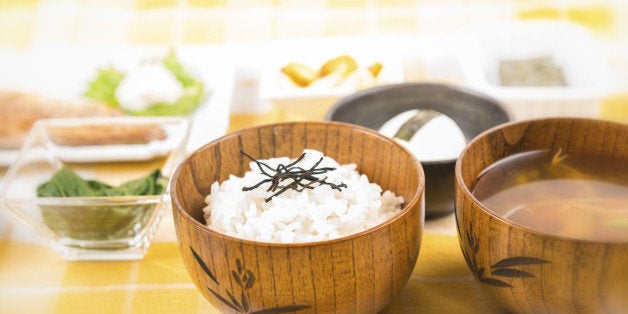
If I were Karl Ove Knausgard, I'd tell you what I ate for breakfast. Okay, I'll tell you anyway. Oatmeal with tahini. Ricotta cheese with honey and slivered almonds. Grapefruit and orange juice mixed 50/50. But why do you care what I had for breakfast? If you bear with me the length of this post, which asks a lot less of your time than Karl Ove Knausgard does with his six-volume autobiographical novel, My Struggle, I'll tell you.
My breakfast today was very Zen. I mean that literally, not the way many people use the word, as a synonym for something peaceful or paradoxical. It's the kind of meal I learned to cook and eat as a Zen student, served in three nested bowls wrapped in cloth, in a formal style of eating called oryoki, which is like a combination of ballet and mime and camping and fine dining all in one. The meal is eaten in the zendo, or meditation hall. It's served by Zen students to Zen students, in a highly ritualized manner.
For breakfast, the first bowl is a grain. The second is juice or soup or yogurt. The third is usually something savory and with protein like tofu or nuts or occassionally, eggs. You take only what you can eat, then you clean your bowls with hot water (no soap) served to you at your seat. You drink the water, after chanting that it "tastes like ambrosia," and it really does, even as it also tastes faintly of breakfast. Then you offer the washing water to Buddha when the servers come around with collection bowls.
One time in a meditation intensive I was moved to tears when I noted how my bowls were empty when unwrapped at the start of the meal, then filled with food, then returned to emptiness before I wrapped them up again. Why did this make me cry? Because I realized that like my bowls, I was empty, then full, then empty (or hungry) again, in endless cycles. Breakfast was teaching me something, and I'm not talking about cereal box trivia. Breakfast was teaching me how life is.
It can be amusing, and instructive, to watch my reactions to what appears in my bowls. Am I grateful, or do I want to spit it out? Do I want more than I need? Or less? Do I gauge what I take based upon what others will think? Do I picture poor, sad cows when someone offers me dairy yogurt, and raise my palm to signal that I'm declining that dish, and do I consider myself slightly better than those who take the yogurt? Or (as is true in my case), do I feel an annoyance at fussy eaters that I'm not particularly proud of?
Last year, I didn't want to eat much of what was put into my bowls. Or, framed slightly differently, my bowls were empty more than they were full. I had a long bout of writer's block. Some people I loved and my beloved elderly cat suffered and died. One of the deaths was a horribly violent one, right outside the Zen center where I've practiced for the last ten years. Since my temperament is more hermit-monk than self-revealing Norwegian novelist, I didn't feel inclined to make art of all this emptiness. More accurately, I couldn't. My bowls were empty.
After the death of my cat Eva late last year, I washed all her stainless steel bowls with the rubber nonskid bottoms and put them away. I gave away her uneaten food. Not long after, the sense of anchoring loss began to lift. I don't know why. I only know that I felt a shift, a sense of restored appetite and the capacity for satiation.
So, back to the image of the nested bowls filling and then emptying, and why I'm telling you this. Maybe you eat poached eggs every day. Maybe your idea of breakfast is a cup of black coffee. You don't have to cry over a Zen breakfast to see that life doesn't always bring you what you want, that there are ebb periods when everything good seems to recede and leave you standing on a dry beach with all the sea's rotting, stinky detritus. But when else would you find shells or see starfish?
Maybe you already know what I'm going to say next. Life isn't made-to-order. Sometimes it's too salty and sometimes it's so sweet it makes you pucker. Sometimes you literally can't eat it, and you have to hold up your hand and politely but firmly refuse. It may be helpful at such times to remember: the bowls fill and the bowls empty. They don't stay full. They don't stay empty. And what's meaningful is not so much what's in the bowl (or not in it) but that we experience the fullness and the emptiness and completely taste our lives.
I can't say I wouldn't pick abundance over paucity, given the choice. A Buddha might. I'm just an ordinary person who still likes to eat bacon. But in my experience, it's definitely been true that happiness tastes better when it isn't what's always in the bowl.